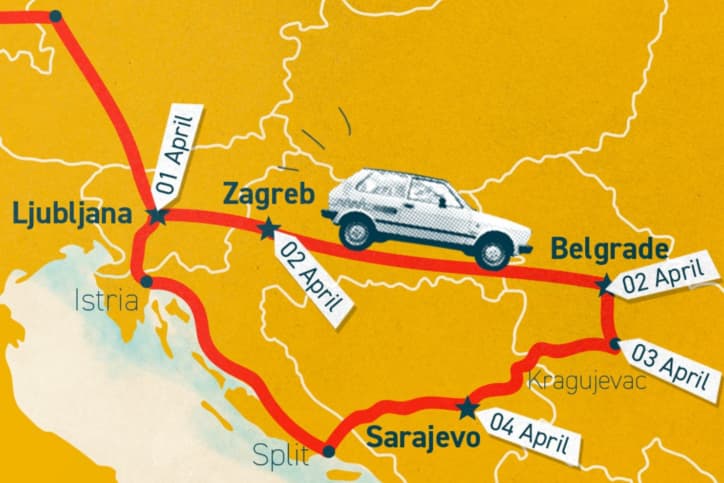The Balkans is a region rich in history, diverse culture, and picturesque landscapes. The territory of the former Yugoslavia is today divided into several independent countries: Slovenia, Croatia, Serbia, Bosnia and Herzegovina, Montenegro, North Macedonia, and Kosovo. Traveling through these countries by car allows you not only to get acquainted with local attractions but also to enjoy nature, unique cuisine, and the hospitality of local people. For readers from the Czech Republic, such a route is becoming increasingly popular due to its accessibility and the possibility to flexibly plan the trip.
Preparation for the Trip and Route Selection
Before setting off, it is important to plan your route, taking into account the number of countries you want to visit and the specifics of traffic regulations in each. The Balkan countries are connected by good highways, but in some places, roads may be mountainous and narrow, especially in Montenegro and Bosnia. It is easiest to enter the region from the Czech Republic through Slovenia — the westernmost of the former Yugoslav countries, with well-developed road networks and modern infrastructure.
It is advisable to study vehicle requirements in advance: check the validity of your driving license, the availability of mandatory “green card” insurance, and prepare your car documents. Some countries require payment of road fees — for example, Croatia and Slovenia operate vignette or toll systems. It is important to take this into account to avoid fines and unexpected expenses.
Features of Driving and Safety
Traffic rules in the former Yugoslav countries are similar to European standards but have some nuances. The speed limit in cities is usually 50 km/h, on rural roads from 80 to 90 km/h, and on highways up to 130 km/h. Drivers in the region sometimes have a distinctive driving style, which requires particular attention, especially in mountainous areas with winding roads and limited visibility.
Fuel at gas stations is relatively inexpensive, and the network of filling stations is well-developed in main tourist areas. However, in remote locations, it is worth planning refueling ahead. Be prepared for the fact that in the mountains, road surface quality may deteriorate, and weather conditions may affect road accessibility, especially in winter.
Cultural and Natural Attractions Along the Way
Traveling by car through the Balkans gives a unique opportunity to visit many diverse places. In Slovenia, attention should be paid to Lake Bled with its picturesque island and castle, as well as to the capital Ljubljana, known for its green atmosphere and architecture. Croatia attracts tourists with its Adriatic coastline, featuring cities like Dubrovnik and Split, where ancient history meets modernity.
Serbia and Bosnia impress with historical monuments and colorful bazaars. Belgrade is a city with a dynamic nightlife and centuries-old history, while Sarajevo is a meeting point of Eastern and Western cultures. Montenegro offers mountain landscapes, national parks, and a stunning coastline with the Bay of Kotor, recognized as a UNESCO World Heritage Site.
A car trip through the Balkans allows you to immerse yourself in natural diversity—from mountain passes to Mediterranean beaches—as well as get acquainted with traditional cuisine and local customs that reflect the rich historical heritage of the region.
Practical Tips for a Comfortable Journey
For a comfortable trip, it is advisable to have a navigator with updated maps, as some roads may be poorly marked and mobile internet in the mountains may be unstable. It is also recommended to carry cash in local currencies — the euro is accepted in most countries in the region, but in some places, local money may be required.
Plan stops in small towns and villages where you can try authentic cuisine—grilled meat dishes, fresh seafood, and traditional desserts. This will not only diversify your rest but also allow you to feel the atmosphere of each place.
In a car journey, flexibility is important—the ability to change plans, stop in unexpected places, and enjoy a leisurely drive. The Balkans offer many hidden gems not always described in tourist guides.
Conclusion
Traveling the roads of the former Yugoslavia is a unique experience that allows you to discover the diversity of Balkan culture, history, and nature. A car gives freedom of movement, letting you explore not only popular cities but also remote corners of the region. For Czech tourists, such a route is becoming increasingly accessible and attractive thanks to developed infrastructure and favorable geographic location.
Proper preparation, careful attention to driving specifics, and a desire to discover new things will help make your trip bright, comfortable, and safe. The Balkans by car is a journey that will remain in your memory for a long time, filling it with impressions and new discoveries.
